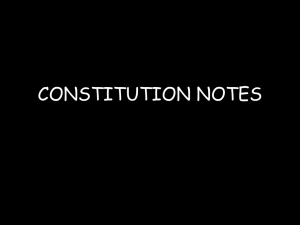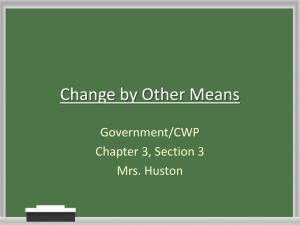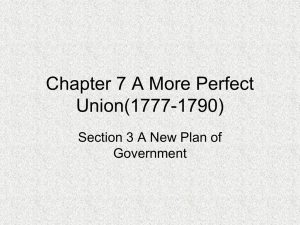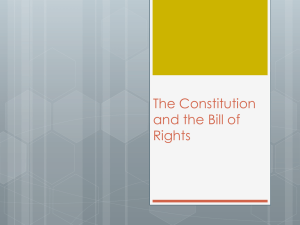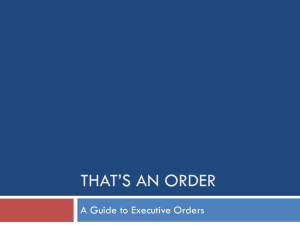Ch. 3 Section 3-The Structure of Our Constitution
advertisement
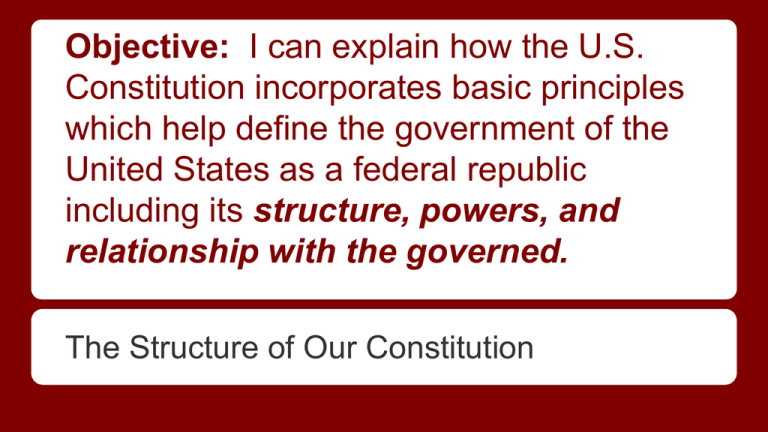
Objective: I can explain how the U.S. Constitution incorporates basic principles which help define the government of the United States as a federal republic including its structure, powers, and relationship with the governed. The Structure of Our Constitution The Sections of The Constitution Constitution ● Framework of gov’t ● Highest authority in the nation ● Basic law of US ● Powers of branches come from it ● Symbol-represents our system of gov’t and our basic ideals, such as liberty and freedom The Sections of the Constitution 3 Main Parts of the Constitution 1) Preamble-intro that states the goals and purposes of the gov’t 2) Seven articles that describe structure of gov’t 3) 27 Amendments or additions and changes to the Constitution The Preamble Single sentence… “We the People of the United States, in Order to form a more perfect Union, establish Justice, insure domestic Tranquility, provide for the common defence, promote the general Welfare, and secure the Blessings of Liberty to ourselves and our Posterity, do ordain and establish this Constitution for the United States of America.” The Preamble ● Carefully chosen words make clear that the power of gov’t comes from the people ● The gov’t depends on the people for its power and exists to serve them The Preamble Middle part of Preamble states six purposes of gov’t: 1) To form a more perfect Union--to unite the states so they can operate as a single nation, for the good of all The Preamble 2) To establish Justice--to make certain that all citizens are treated equally 3) To insure domestic Tranquility--to maintain peace and order, keeping citizens and their property safe from harm The Preamble 4) To provide for the common defense-to ready militarily to protect the country and its citizens from attack 5) To promote the general Welfare--to help people live healthy, happy, and prosperous lives The Preamble 6) To secure the Blessings of Liberty to ourselves and our Posterity--to guarantee the basic rights of all Americans, including future generations (posterity) Partner Questions 1) What is the Preamble? 2) Are the six purposes of gov’t listed in the Preamble enough? Should their be less or more purposes listed in the Preamble? Explain why!!! The Articles The first three articles describe the powers and responsibilities of each branch of gov’t. Article I=Legislative Branch Article II=Executive Branch Article III=Judicial Branch The Articles ● Article I outlines the lawmaking powers of the legislative branch, or Congress. ● States that Congress, made up of two houses-Senate and House of Representatives--will have all lawmaking authority ● Describes how members of each house will be chosen and what rules they must follow in making laws (Ch. 6) The Articles ● Article II provides for an executive branch, or law-enforcing branch of gov’t headed by a president and vice president. ● Explains how these leaders are to be elected and how they can be removed from office. ● List the president’s powers, including the power to command the armed forces and to make treaties with other nations. (Ch. 7) The Articles ● Article III calls for “one Supreme Court” and such lower courts as Congress deems appropriate. ● The Judicial branch is the part of government that interprets the laws and sees that they are fairly applied. ● Lists the powers of the federal courts and describes what kinds of cases they may hear. (Ch. 8) The Articles ● Articles IV explains the relationship between the states and the national gov’t. ● Article V specifies under what conditions the Constitution can be changed. ● Article VI contains a key statement declaring the Constitution the “supreme Law of the Land.” ● Article VII states the Constitution would take effect when nine states ratified it. Partner Questions 1) Article 1=_________________ Branch Power=___________________________________ ___ Title=______________=__________+___________ ___ 2) Article 2=__________________ Branch Power=___________________________________ ___ Title=________________&____________________ ___ 3) Article 3=___________ Branch Tomorrow! Bring your textbook tomorrow! Current Event Presentations ● Pass Current Event Handout forward ● Please be respectful (Quiet/Paying Attention) during the presentations ● Hand your rubric to Mr. Dial Objective: I can explain how the U.S. Constitution incorporates basic principles which help define the government of the United States as a federal republic including its structure, powers, and relationship with the governed. The Structure of Our Constitution Amending the Constitution ● Any change in the Constitution is called an amendment. ● Thousands of amendments have been considered over the years, but only 27 have become law ● Framers deliberately made the amendment process difficult Partner Question Why did the framers make the amendment process so difficult? Amending the Constitution ● The ability to amend the Constitution is necessary ● Constitutional amendments safeguard many of our freedoms ● For example, the abolition of slavery and the right of women to vote were added as amendments Amendment Process ● Process outlined in Article V ● Two Steps o Proposal o Ratification Amendment Process ● An amendment may be proposed in either of two ways ● The first method--used for all amendments so far--is by congressional action o Vote of ⅔ of members of both houses of Congress is required Amendment Process ● The second method is by a national convention requested by ⅔ of the state legislatures (Has not been used up to this point in time) Partner Question What are the two methods to propose a Constitutional amendment? Ratifying an Amendment ● Once a national amendment has been proposed, ¾ of the states must ratify it ● The states have two ways to ratifyo o by a vote of either the state legislature or by a special state convention Only one amendment, the 21st, has been ratified by means of state conventions Partner Question ● Explain what happens next after a Constitutional amendment has been proposed. o Who has to ratify and by how much? o What are the methods to ratify? Interpreting the Constitution ● Framers knew world would change in ways they could not predict ● For this reason, they attempted to keep the document as general as possible ● Some matters they went into great detail, while other matters they left open to interpretation The Necessary & Proper Clause ● Article I list the powers of Congress ● “to make all Laws which shall be necessary and proper” to carry out its duties ● This clause allows Congress to exercise powers not specifically listed in the Constitution ● These powers are known as “implied powers” The Necessary and Proper Clause ● Not everyone agrees which laws are “necessary and proper” and which laws are not ● Loose interpretation-Congress should be allowed to make any laws the Constitution does not specifically forbid ● Strict interpretation-Congress should make only the kinds of laws mentioned by the Constitution Court Decisions ● final authority to interpret Constitution rests with Supreme Court ● Over the years, the Supreme Court has interpreted the Constitution in different wayssometimes, strictly, sometimes loosely. ● With each new interpretation, our gov’t changes Legislative and Presidential Actions ● Actions of Congress and executive branch have also caused new interpretations of Constitution ● House of Representatives (prosecutors) are allowed to impeach, or accuse, federal officials, while the Senate (jury) determines the person’s guilt or innocence. Legislative and Presidential Actions ● Nowhere in the Constitution does it state that the president should propose bills or budgets to Congress ● Yet since the presidency of Woodrow Wilson (1913-21), each year the president proposes hundreds of bills to Congress Legislative and Presidential Actions ● Presidents interpret the Constitution in other ways, too. ● Not only does the president make agreements with other countries without congressional approval, the president also requests legislation from Congress ● The Constitution does not direct the president to take these actions Interpretation Through Custom ● Interpretation of the Constitution has changed through customs that have developed ● Example-the Constitution does not mention political parties, yet they are an important part of today’s political system ● These days, parties help organize the gov’t and conduct elections Interpretation Through Custom ● Constitution present day is quite different from the document written in 1787 ● No doubt it will go through more changes into the future ● However, the basic structure and principlesa delicate balance among three brancheswill remain Partner Questions 1. Write a paragraph about the Constitution in which you use these terms: Preamble, legislative branch, executive branch, judicial branch, amendment 2. Why has the Constitution been called a blueprint for governing the United States? 3. How are the states involved in the process of ratifying an amendment? Partner Questions 4. Why have only 27 amendments been added to the Constitution? 5. Review the chart “Comparing Governments” from a last week. How does the power to tax differ under both forms of government? Partner Questions 6. Complete the chart below by listing important details of each part of the Constitution. Part Preamble Articles Amendments Detail





